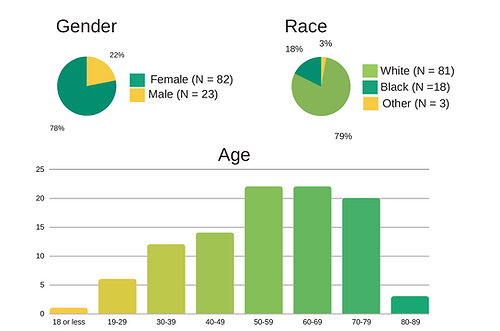
Our Process
Developing the Strategic Plan
The Age-Friendly Louisville Strategic Plan is the result of over a year's worth of community feedback, spanning multiple surveys and over nine community meetings. The final action projects incorporated the feedback from the 2017 KIPDA Needs Assessment, recommendations from the Age-Friendly Advisory Group, over nine Domain Workshops (March 2017 - May 2017) and a "Go Zone" Analysis.
We invite you to scroll through our steps below to learn more. Have questions? Send us a message!

Community Feedback
1
KIPDA Needs Assessment
The 2017 KIPDA Needs Report, conducted by the UofL Institute for Sustainable Health & Optimal Aging, analyses the social service needs of the seven county region served by the KIPDA Area Agency on Aging and Independent Living, including Jefferson County. Research methods included data analysis from the US Census, CDC, and Community Commons and a survey of country residents with over 721 respondents (with Jefferson county having the most at 469 responses). The needs of the county were analyses through the age-friendly domains of livability. The full report is available here.
2
Domain Workshops
Beginning March 7, 2018 the Domain Workshops spanned a wide variety of neighborhoods, times, and days of the week. The AFL leadership wanted to ensure that neighborhoods and communities had the opportunity to discuss the four chosen domains as they related to their particular neighborhood. Most workshops were held at pubic libraries with a few others taking place at either government or aging-related non-profit organizations (including two older adult community centers). The locations were all accessible for those with restricted mobility. The timing of the workshops was intentionally varied - including weekends, mornings, afternoons, and evenings.

Project Prioritization
1
Workshop Data Analysis
After the completion of all eight workshops, a team from the UofL Institute for Sustainable Health & Optimal Aging read all the transcripts of the workshops to find initial codes which where turned into a code book. Transcripts were then coded again for strengths, barriers, and strategies using Dedoose, a Qualitative Analysis Software program. The Institute team reviewed the results to identified actionable programs. The final list of actionable projects was then simplified and edited by the whole AFL leadership. This final list was then turned into the “Go-Zone” Analysis Survey (see below).

Dedoose Interface
2
Go Zone Analysis: Project Prioritization Tool
Survey
In order to determine the final action projects for AFL strategic report, all participants of the workshops and the Advisory Group to attend a Domain Workshop Debrief on June 28, 2018. Attendees were asked to complete the “Go-Zone” Analysis Survey which asked people to rank each project based on feasibility and importance. Click here to view the survey. The UofL Institute for Sustainable Health & Optimal Aging then conduced a “Go-Zone” Analysis on the data from the survey to determine the projects the community felt should be addressed by the current AFL strategic action plan.
36 surveys were completed.

Results
The Go-Zone analysis was conducted on the results of the survey. A "Go-Zone" Analysis is an evidenced-based method of using ratings from the community to prioritize projects based on their relative importance and feasibility. The results of this analysis helped Age-Friendly Lousville to determine the first projects it should focus on for the initial strategic plan.
1
Relative Importance v. Relative Feasibility "Ladder"
This "ladder" shows the relative overall importance against the relative overall feasibility of the average scores for all the projects in each of the domains.
For most of the domains, the relative overall importance ranking matched the relative overall feasibility ranking - with two interesting exceptions. Housing, which was ranked third in overall importance, ranked least in feasibility. This indicates that while the participants viewed housing as important, the housing-related projects were overall the least feasibility to accomplish. Similarly, Communication & Information was ranked least in importance but first in feasibility. Overall, participants felt that projects relating to Communication & Information were not as important compared to the other domains but they would be the easiest (most feasible) to accomplish.

2
Go Zone Scatter Plot

Mean Importance
Mean Feasibility
GO-ZONE
HOLD
HOLD
LATER
The Go Zone Scatter Plot organizes all of the projects into four areas of prioritization:
1. Go-Zone (green): high importance & high feasibility
2. Hold (yellow): low importance & high feasibility
3. Hold (yellow): high importance & low feasibility
4. Later (red): low importance & low feasibility
The boarders for the zones were created by finding the mean importance score for all projects and the mean feasibility score for all projects. These identified the bright blue lines on the scatter plot above that divide all projects into four prioritization quadrants.
To note, all projects identified by the survey were considered very important as these were all issues derived from community feedback at the domain workshops. Rather, analysis reflects only relative importance and feasibility.
Click on the below buttons to see the exact projects and their relative prioritization for each domain:

Housing

Social Participation, Respect & Inclusion
Communication & Information


Mobility & Access


